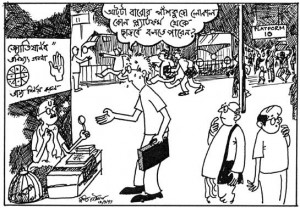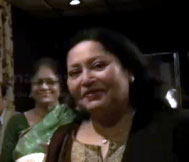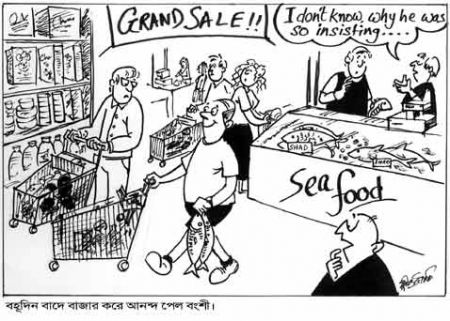Many years ago, when I used to work in Kolkata, I used to commute regularly between Howrah and Kharagpur. The drill was something like this. After reaching Howrah station and buying my ticket, I walked down to the extreme left end of the station. By then a large crowd has already assembled at a strategic location from where one can see the electronic display as well as reach any of the potential platforms where the train is expected to arrive which is almost impossible to predict. Suddenly the huge crowd starts moving in a massive frenzy. This usually means that the electronic board has displayed the desired information. Travelling light is extremely important, since in that tsunami, it is extremely important that you do not disturb the stream line motion. A huge luggage, or a slow moving elderly can create a massive turbulence. And then when the train arrived, one needs to prepare himself for the next battle – to get onboard and then to get a seat. Continue reading
Tag Archives: cartoon
Loss of a Friend
Three months ago, when I lost my mother, I received the following email from a close friend:
The email was from Gayatri Gamarsh (who allowed me to call her as Gayatri-di) and it really helped me cope with my pain. Little did I know that three months later, Gayatri-di herself will move on to “her after-life” leaving us behind mourning her loss.
I came to know Gayatri-di mainly through her literary works and her love for anything artistic. She used to love coming to our plays and appreciated them very much. Several times she has written about our plays in Anandasambad and other magazines. Her appreciation and encouragement meant a lot to me and my team mates. It is for people like Gayatri-di that makes all the hard work in writing and staging a play worth it.
In September, she had participated in a workshop on creative Bengali writing conducted by Sunil Gangopadhyay. She had rescheduled her heart surgery just to attend this workshop online. That was the last time I had heard her voice on the phone. Later, after her surgery, she had sent me an email asking for an article or cartoon for the “Sambad Bichitra” English section. But I never had the chance to hand it to her.
As mentioned by Gayatri-di in her email, I’ll believe that she is always with us and will be watching any play we put up or read any article I write or any cartoon I draw.
Goodbye Gayatri-di and thank you for all your encouragement and blessings, for those will be my source of inspiration for whatever I do in the future.
Cartoon of the Week 16: Healthcare Costs

I drew this cartoon long time ago to highlight the healthcare cost crisis. For the benefit of the readers who don’t read Bengali let me explain it a bit. The doctor looking at his patient’s charts comments that he is not concerned with his lab reports but he is concerned about his bank statement reports which of course is not good enough to bear the cost of treatment.
Healthcare cost management, one of the major election issues last year, is once again in the back burner – being overshadowed by the economic meltdown. Although the recent economic stimulus package contains a provision to modernize health-care record keeping which can potentially reduce some of the costs and also provide for some computer programming jobs, it can hardly put a dent on this monstrous problem. Health-care cost is poised to be the next bubble to burst and it can also have devastating effects on the population and businesses. This needs to be dealt with as soon as possible before the entire system disintegrates. Many hospitals are reporting higher rates of ER admissions for patients without insurance. This is expected with the high unemployment numbers. Soon the hospitals will be asking for bail out money. Continue reading
Cartoon of the Week 15: Train Travel
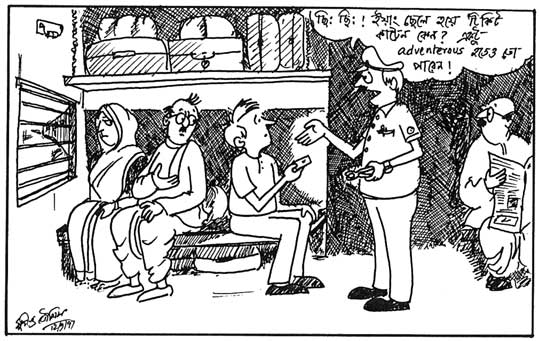 Traveling long distance by train was one of the most enjoyable modes of transportation in India. Once you get over the initial hurdles of getting a reserved seat or squeeze yourself in through the crowded doors as the train slowly rolls in to the platform or the frantic attempts to manage the porter and the family, the journey becomes much easy and enjoyable. Overnight train rides are especially thrilling when you not only need to manage a berth to sleep, but also keep an eye on your luggage and belongings to protect them from the “highly suspicious” co-passengers around you. When I was a child, I remember the train journeys from Kolkata (Sealdah or Howrah depending on which train you take) to Siliguri. Before the Farrakka bridge (barrage) was completed, we had to get off the train at Farakka and then take a steam boat across the Ganges to the other side (Sagrikoli Ghaat) and then scramble on to the train after a long run. If you were unlucky enough of not having a proper reservation, then your plight can only be imagined by those who took that journey. However, once you are settled in your seats or berths, temptations start knocking on your senses as the aroma of hot food attracts your attention along with the loud marketing attempts by the food vendors on the station. The appetizing offerings of “Ilish Maachher Jhol”, “Bhaaja Mooger Daal”, “Gorom Bhaat with Ghee” and “Begun Bhaja” pulls in many hungry passengers to the bamboo and hay thatched eateries all around the train station. Continue reading
Traveling long distance by train was one of the most enjoyable modes of transportation in India. Once you get over the initial hurdles of getting a reserved seat or squeeze yourself in through the crowded doors as the train slowly rolls in to the platform or the frantic attempts to manage the porter and the family, the journey becomes much easy and enjoyable. Overnight train rides are especially thrilling when you not only need to manage a berth to sleep, but also keep an eye on your luggage and belongings to protect them from the “highly suspicious” co-passengers around you. When I was a child, I remember the train journeys from Kolkata (Sealdah or Howrah depending on which train you take) to Siliguri. Before the Farrakka bridge (barrage) was completed, we had to get off the train at Farakka and then take a steam boat across the Ganges to the other side (Sagrikoli Ghaat) and then scramble on to the train after a long run. If you were unlucky enough of not having a proper reservation, then your plight can only be imagined by those who took that journey. However, once you are settled in your seats or berths, temptations start knocking on your senses as the aroma of hot food attracts your attention along with the loud marketing attempts by the food vendors on the station. The appetizing offerings of “Ilish Maachher Jhol”, “Bhaaja Mooger Daal”, “Gorom Bhaat with Ghee” and “Begun Bhaja” pulls in many hungry passengers to the bamboo and hay thatched eateries all around the train station. Continue reading
Cartoon of the Week 13: Prediction
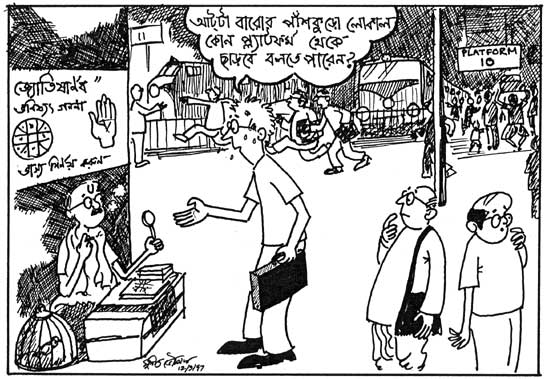
Many of us are strong believers in astrology and other similar practices like palmistry, tarot cards etc. etc. that claim to predict one’s future. A huge industry runs on servicing such people and also provides employment to millions. The television and other media advertisements of such sooth sayers and fortune tellers prove that they earn enough money to invest in these marketing campaigns. The precious and semi-precious gem stone market in India depends on the belief that the negative influence of the planets and stars can be countered by wearing a specific kind of gem stone that can cost thousands of rupees. Continue reading
Cartoon of the Week 11: Sheer Pleasure
Cartoon of the Week 10: The Power of Salt
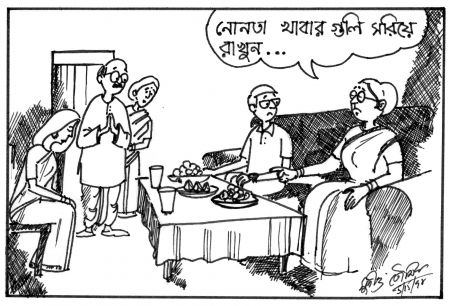 In the famous Bengali play “Alibaba” by Khirodprasad Bidyabinod, when the righteous dacoit chief came as a guest to Alibaba’s home – he mentioned about one diet restriction that he had – he doesn’t eat salt. Obviously his salt restriction was not because of hypertension or any other nephrological disease that he might have had (the playwright did not give any clues except that he was quite hot tempered). He didn’t want Alibaba to serve him any salty food because then he would have had to pay for his salt indebtedness. He would no longer be able to kill Alibaba and his family and loot back his wealth. He could never be a “Namak Haram”! Such is the power of salt. This mythological power of salt has been used as a test of ones righteousness. If you ever ingest salt served by somebody, you should always sing his praise – in Bengali we say “Noon khai jaar – Goon gai taar!” But these days we hardly obey such silly dictum. Continue reading
In the famous Bengali play “Alibaba” by Khirodprasad Bidyabinod, when the righteous dacoit chief came as a guest to Alibaba’s home – he mentioned about one diet restriction that he had – he doesn’t eat salt. Obviously his salt restriction was not because of hypertension or any other nephrological disease that he might have had (the playwright did not give any clues except that he was quite hot tempered). He didn’t want Alibaba to serve him any salty food because then he would have had to pay for his salt indebtedness. He would no longer be able to kill Alibaba and his family and loot back his wealth. He could never be a “Namak Haram”! Such is the power of salt. This mythological power of salt has been used as a test of ones righteousness. If you ever ingest salt served by somebody, you should always sing his praise – in Bengali we say “Noon khai jaar – Goon gai taar!” But these days we hardly obey such silly dictum. Continue reading
Cartoon of the Week 9: Are we Missing Something?
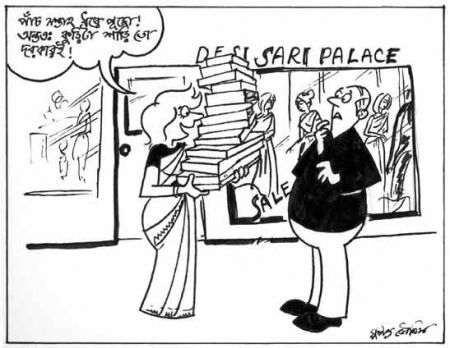 From the recent comments and postings on this and other blogs and from the “addas” at various Bijoya Sammilani parties, I keep on getting a constant message – maybe we are missing the good old style Durga Puja as it used to happen in this part of the world. We all can agree on one thing that back home, the Bijoya Dashami was one of the saddest day of the year. No amount of “Naru”, “Laddu” or “Ghugni” could sweep away the sadness. But when we came to this country, we discovered that Durga Puja does not have to end on one specific day. Continue reading
From the recent comments and postings on this and other blogs and from the “addas” at various Bijoya Sammilani parties, I keep on getting a constant message – maybe we are missing the good old style Durga Puja as it used to happen in this part of the world. We all can agree on one thing that back home, the Bijoya Dashami was one of the saddest day of the year. No amount of “Naru”, “Laddu” or “Ghugni” could sweep away the sadness. But when we came to this country, we discovered that Durga Puja does not have to end on one specific day. Continue reading
Cartoon of the Week 4: Pujor Chanda
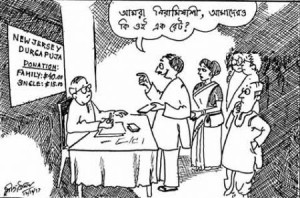 Pujo contribution or Chaanda (as we fondly call this concept) is always an issue with the average Bengali. Be it in India or in USA, Bengalis have the feeling that this is an unjust extortion in the name of a festival that we all like to attend. It should be free for all of us. Where the organizers get their funds is not for us to bother about. Since, most of the Pujo organizers make it a point to ensure that each and every attendee pays their contribution, we’d like to get away with the minimum amount that helps us to claim a stake in the festival. But the Pujo organizers these days are smart, they make the contribution amount quite obvious by displaying it in bold font. To justify the specified amount, the organizers will cite different components of the cost incurred to hold a festival of this magnitude, like goat meat, Mumbai and Kolkata performers – etc etc. This cartoon raises a legitimate question – why not an a-la carte system for Pujor Chanda? Sounds fair to me!
Pujo contribution or Chaanda (as we fondly call this concept) is always an issue with the average Bengali. Be it in India or in USA, Bengalis have the feeling that this is an unjust extortion in the name of a festival that we all like to attend. It should be free for all of us. Where the organizers get their funds is not for us to bother about. Since, most of the Pujo organizers make it a point to ensure that each and every attendee pays their contribution, we’d like to get away with the minimum amount that helps us to claim a stake in the festival. But the Pujo organizers these days are smart, they make the contribution amount quite obvious by displaying it in bold font. To justify the specified amount, the organizers will cite different components of the cost incurred to hold a festival of this magnitude, like goat meat, Mumbai and Kolkata performers – etc etc. This cartoon raises a legitimate question – why not an a-la carte system for Pujor Chanda? Sounds fair to me!
Cartoon of the Week 3: The Selection Process
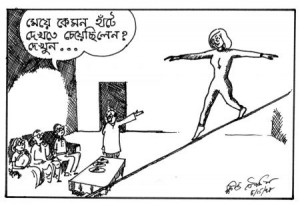 Arranged marriage is still quite common in India, and one important phase in an arranged marriage is the process of selecting the bride. Mind you, I said “bride selection” and not “groom selection”. An important component of this process is to visit the bride’s home and conduct an interview of the girl to figure out if the girl is a suitable candidate. In some cases, the girl is not only asked to provide verbal answers to the questions, but also demonstrate their gait, posture, length of the hair and also their artistic, musical, and culinary skills. This cartoon was drawn to emphasize on this aspect of the selection process – the girl demonstrates her gait by walking on a tight rope. After all, that’s what she will have to do everyday at her in-laws family – walk the fine line with amazing dexterity, balance and skill. Women of our country may not be participating at the Olympics gymnastics events, but this skill of walking the horizontal beam is in their genes. This cartoon was done for Proma (published from Kolkata) few years ago. I thought this would be an interesting post during this Olympic season.
Arranged marriage is still quite common in India, and one important phase in an arranged marriage is the process of selecting the bride. Mind you, I said “bride selection” and not “groom selection”. An important component of this process is to visit the bride’s home and conduct an interview of the girl to figure out if the girl is a suitable candidate. In some cases, the girl is not only asked to provide verbal answers to the questions, but also demonstrate their gait, posture, length of the hair and also their artistic, musical, and culinary skills. This cartoon was drawn to emphasize on this aspect of the selection process – the girl demonstrates her gait by walking on a tight rope. After all, that’s what she will have to do everyday at her in-laws family – walk the fine line with amazing dexterity, balance and skill. Women of our country may not be participating at the Olympics gymnastics events, but this skill of walking the horizontal beam is in their genes. This cartoon was done for Proma (published from Kolkata) few years ago. I thought this would be an interesting post during this Olympic season.

